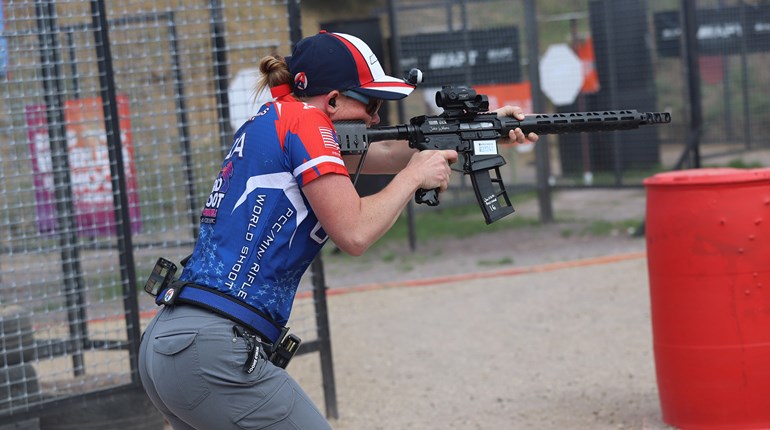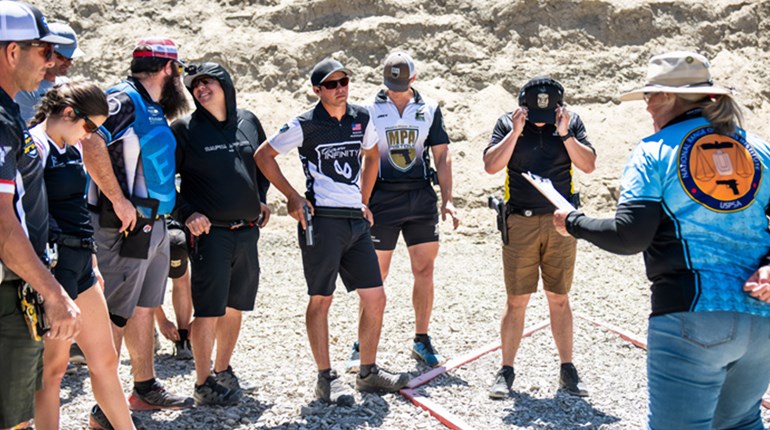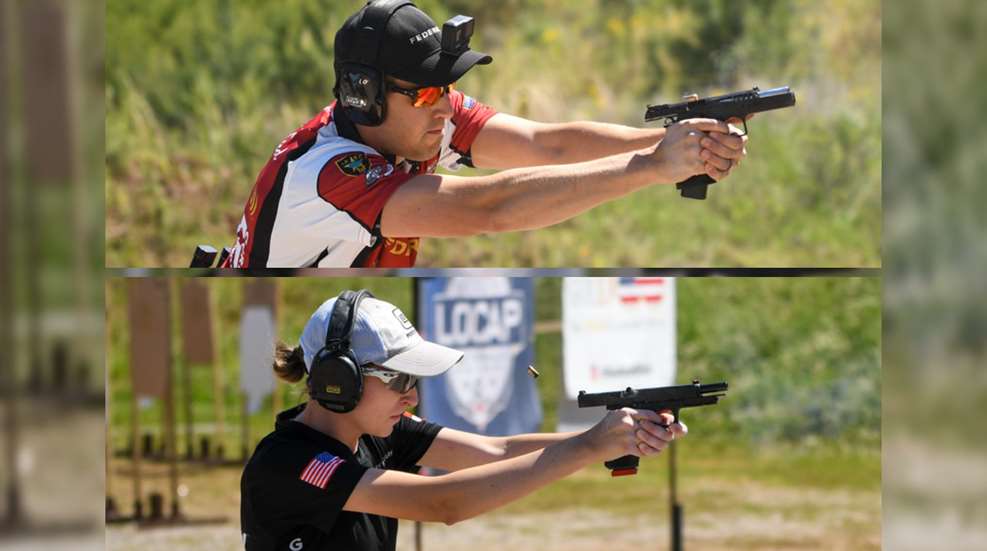
Spread out over 500 acres, the CMP Talladega Marksmanship Park played host to the 414 competitors who took on the 20 stages of the 2021 USPSA LOCAP National Championships. For over five days of competition, two days for staff followed by three days of shooting for regular competitors, we would find out who was the best in the low-capacity divisions of Production, Single Stack, Revolver and L10 for 2021.
The staff would get the first crack at the stages, shooting them over May 5-6. Nearly the entire staff of dedicated volunteers would compete in the National Championship and then work their stages for the following three days for the regular competitors to shoot in half-day format. The range was divided into three zones, so competitors would either shoot AM/PM/AM or PM/AM/PM, either two mornings and one afternoon, or two afternoons and one morning schedule. The regular competitors would do this Friday, Saturday and Sunday, May 7-9, with each of the squads having five stops per day in each of the zones. The Zones, A, B and C, each had five bays in them, with some of the bays in each zone having two stages to make up the 20 stages for the match.
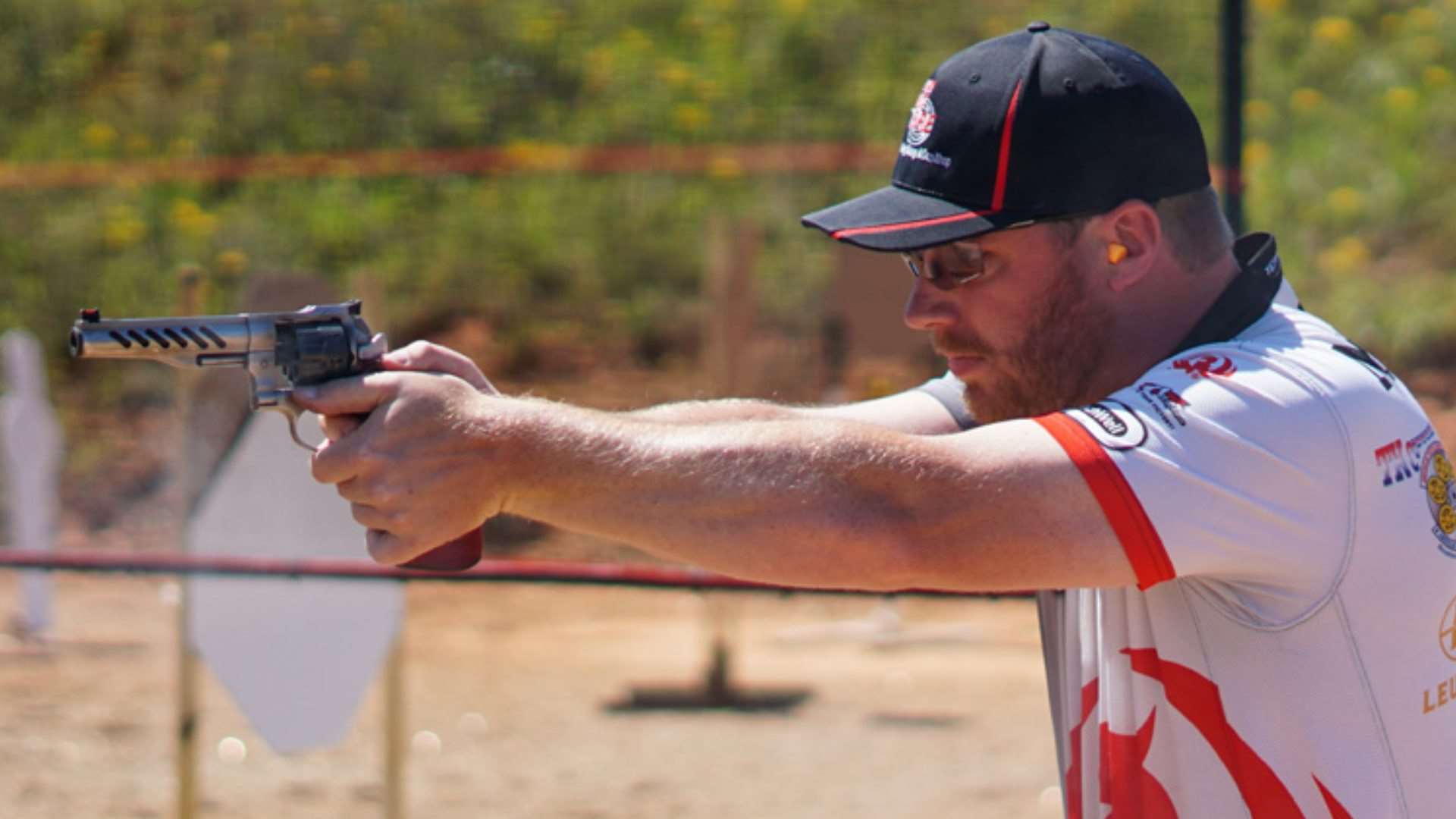
The stages were designed to challenge competitors, taking into account that everyone was shooting a low-capacity firearm. L10 and Production division were limited to no more than 10 rounds in a magazine, Single Stack Major and Revolver divisions no more than eight rounds available and Single Stack Minor had 10 rounds in the magazine. There is always a fine balance in designing stages where everything isn’t “go here, shoot eight, go here, shoot eight,” but to not give a bigger advantage to 10 rounds, especially considering Single Stack division. Major scoring will usually balance out the playing field between eight and 10 rounds; however, if most of the stages favor 10 rounds with less reloads, that isn’t always the case. For the most part, these stages balanced this out, but there were a few that could leave an eight-plus-one-round Single Stack doing a flat-footed standing reload if they were too aggressive on a target array with steel. But with major scoring, there were enough partial targets with hard cover or no-shoots to give major a bigger edge, especially considering how much movement would be required on the large bays.
Before the start of the match, one of the first things that had competitors and staff scratching their heads on were the stage names. Sometimes matches have themes; for example, the 2020 Back to Back Nationals’ stage names were all song titles that were connected for each match. There was some talk about music at matches, so I gave each stage an approved song to play; however, no one ever asked me about playing the song during the walk-through. Funny, I thought that was an issue. This year, Beretta stepped up to be the title match sponsor, so I had some fun with stage names in Italian and Latin. Now knowing that shooters don’t read, and that, unless it is to ask a specific question about rules, they would probably just skip it over and say whatever. However, in this case there were lots of people very curious about the names of the stages and many asked the meaning behind them. Once the “code” was broken, the names became pretty obvious. So, there was nothing too crazy going on with the stage names, just something different. I was told by Nicola Lorenzi from Beretta that my Italian wasn’t great. I blamed Google translator.
In October 2020 (six months prior), Jacob Hetherington held off Mason Lane by 17.78 points (0.8 of a percent) to win Production at the Factory Gun Nationals. They would be back battling it out with JJ Racaza, who took fourth and Nils Jonasson, who took fifth that year. Rob Leatham’s return to the Single Stack podium win was also still pretty fresh from the September 2020 Classic Nationals. He would be defending his title against second place Mike Seeklander and other top ten finishers like Elias Frangoulis, Paul Kerr and Phil Strader. Revolver would have Michael Poggie trying for his fifth Revolver Championship in a row over the other favorites Caleb Higby, Rich Wolfe and Josh Lentz. The race in L10 would not have Blake Miguez back to defend his 2020 title, since the Louisiana house was in session and he was unable to make the match. However, Casey Reed, Gorka Ibanez and Travis Tomasie would be taking on newcomers to the division, Christian Sailer and Team Infinity Junior National Champion in Limited, Gianni Giordano. The stage was set, so to speak, and after two days of staff shooting, the competitors took to the bays that Friday morning to start the next three days of competition.
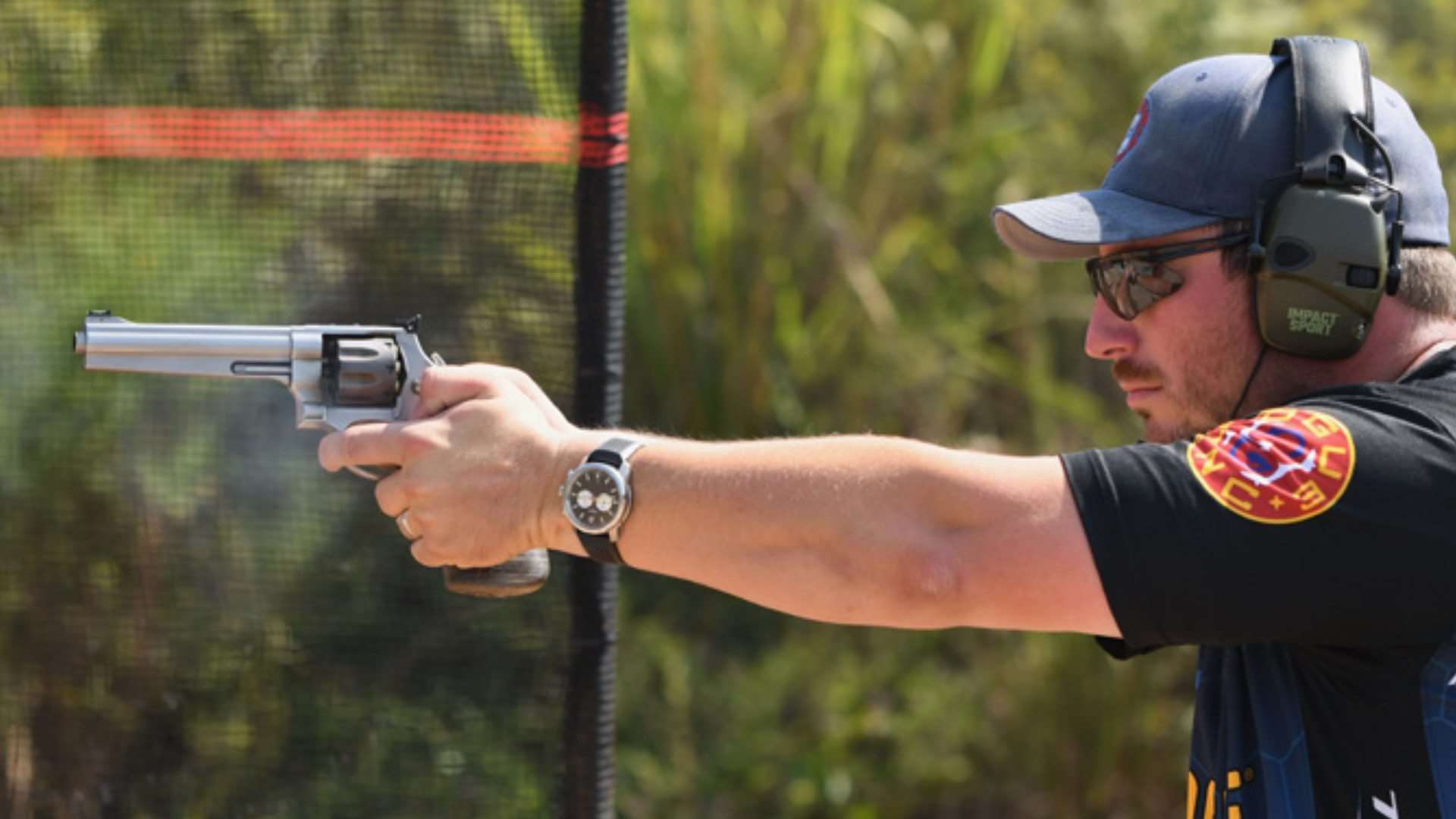
Revolver Race
The Revolver Super Squad started that morning shooting the six stages that made up Zone A. Ruger’s James McGinty took the early lead, winning Stage 1 “Dieci Dieci,” shooting 96 of the available 100 points over Josh Lentz. McGinty would take another 150 point stage win on Stage 2 “Trenta”, with a 26 Alphas and only four Charlies. Poggie was now almost 52 points down, having racked up two misses on this stage. The only 32-round 160-point stage in Zone A, Stage 3, “Triginta Dou” would have Hogue’s Rich Wolfe grab a stage win, with Poggie snagging a much-needed 158.71 points and finishing second here.
Stage 4 “Otto volte tre” and Stage 5 “Scarico” shared the next bay and would also be the last two stages shot in Zone A. The Chrono stop was in this zone for all squads. Poggie won the 120 points available on Stage 4 ahead of Lentz’s faster time but with three more Charlies. Stage 5 was an unloaded facing uprange start with a side-to-side shooting area. The right side had two cardboard targets, one with a tight no-shoot, and three poppers. The left side also had three poppers, two of which were activators. One activated a bobbing target and the other a max trap, both targets visible at rest. The Revolver shooters had to be on their game with only eight rounds as each side of the stage required seven shots, which would leave only one make-up round. Double Alpha’s Josh Lentz took the stage win over Poggie’s second place.
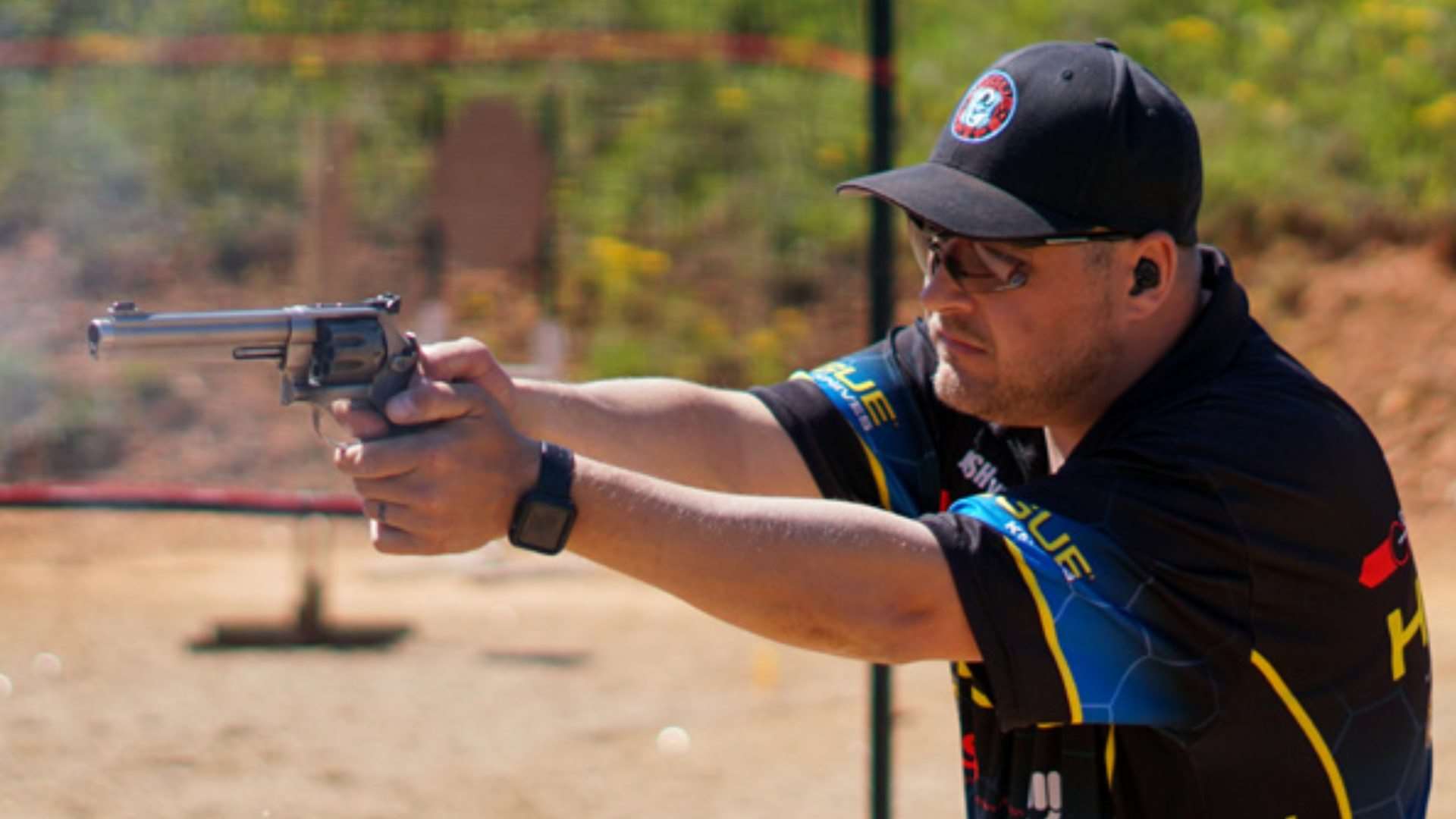
At the end of Day One for the Revo guys, Josh Lentz was in the lead with 570.20 points over James McGinty with 569.91 points. Rich Wolfe was sitting in third with 562.36 points. Poggie and Higby were only 0.21 points apart and essentially tied for fourth.
Zone B had the most points available, 755, and would start Day Two of competition for the top five Revolver shooters on Saturday afternoon.
Stages 6 through 13 that made up Zone B would require 151 rounds at a minimum. While this Zone had the most points up for grabs, there were only two long field courses; everything else was under 20 rounds and had a few tricks in it as well as two Virginia Count stages. Stage 6 “Molti Posti” was a large field course spread out over one of the largest bays at the park. With groups of targets through a port on the right and a low target through a port on the left, competitors were going to be moving a lot. There were some hard set-ups on the far left with no-shoot-covered targets and mini poppers spread out across the bay. Alex Bakken drove his eight-shooter to a stage win here with 30.22 time and Caleb Higby took 151.87 of the available 160 points for second.
Stages 7 and 8 shared the next bay for the squad to work through. Stage 7 “Divertente” was a 14-round stage worth only 70 points, with two shooting areas divided by a vision barrier. Each side had two targets and an activating popper that got very fast swingers going on each side. Bakken carried another stage win here, with Poggie coming in second and just edging out Josh Lentz in third. “Clarus,” Stage 8, was the first Virginia Count stage of the match, worth 80 points. Michael Poggie ran it in 7.32 seconds for a stage win, with Caleb Higby grabbing 68.18 points in second on this eight-reload-eight standards type of stage.
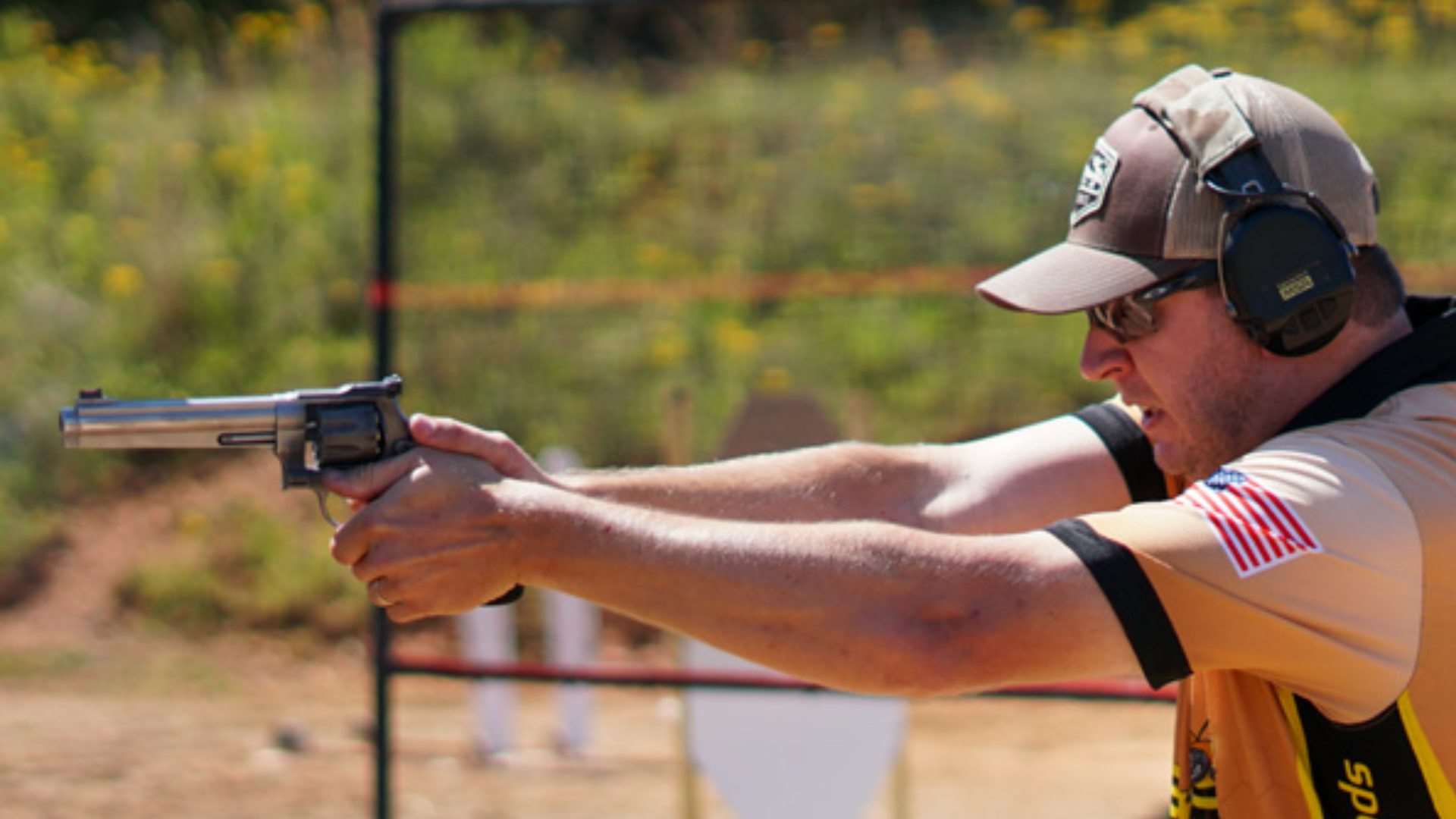
Stage 9 “Lontano” was the other long course in this zone, with 30 rounds required. What looked like a straightforward stage going either right or left actually was more difficult to execute for many competitors. The target presentation gave many options for the shooters on what to shoot from where, as many of the targets were available from multiple positions. Lentz and Poggie went one and two here with Lentz grabbing the 150 points and Poggie picking up 144.08.
With a shooting area in the shape of an L, Stage 10 “Eh-leh” was an 18-round stage with seven cardboard targets and four poppers. Poggie ran this one in 13.15 seconds for the stage win, adding another 90 points to his total. Stage 11 “Rilegato” shared this bay and was the second Virginia Count stage. “Rilegato” means hardcover, and each of the four cardboard targets had hardcover on them. The targets required two rounds each with a mandatory reload, and two rounds each strong hand only. Poggie and Lentz went one and two again on this 80-point stage.
The last two stages in Zone B also shared a bay to round out the second day of competition. Stage 12 “LV” with its wall sections in the shape of the letters L and V was a fast 10-round stage with five cardboard targets. Caleb Higby grabbed the available 50 points ahead of Poggie, followed by Rich Wolfe. Day Two would end on Stage 13, “Quindici,” a 15-round stage with two shooting areas. Competitors started on the far right side box, with four targets in front of them for eight rounds, and would move to the left shooting box that had five poppers and one tip-out target that was activated by the full-size popper. The tip-out would come out on the left side, but would go back to the right side, leaving only the upper A zone visible. It was a hardcover ‘tuxedo’ target that tipped out. The timing was there to get the steel and put two on the tip-out before it snuck back over to the right side. By the time it was moving back, however, you might not be sure you didn’t put one in the black hardcover. Matt Griffin took a stage win here with Higby coming in second.
At the end of Day Two, it would be Michael Poggie that was leading the Revolver division with 1254.13 points, which was 92 percent of the available points from Zones A and B. Josh Lentz moved into second place with 1232.25 points, Rich Wolfe was still in third with 1209.89, Caleb Higby fourth with 1188.83 and James McGinty fifth with 1172.21.
The third and final day would have the cylinder gang starting in the morning session in Zone C. Zone C required 142 rounds for a possible 710 points on Stages 14 through 20. There were two double bays in this zone, and one Virginia Count stage that was going to require some weak-hand shooting. All of the targets in Zone C were IPSC targets which, with an A zone reduced in size compared to that of the USPSA cardboard, was going to put an emphasis on accuracy, especially with minor scoring.
Stage 14 “Due Porte”, as the name suggests, would have the competitors shooting through two ports. There were also four poppers downrange available through an opening in the offset wall sections. The start position was in the center wall section, so competitors were going to move uprange to get to the left-side targets. Higby started Day Three with a stage win, grabbing 130 points over James McGinty in second with 119.32.
Stage 15 “Ventiquattro” was a 24-round, 120-point stage with a side-to-side shooting area that would leave the eight-round guns doing standing reloads if they were not disciplined on the four poppers that were spread out downrange. Michael Poggie won the needed 120 points on this stage over Josh Lentz, who earned 110.24. Poggie would also take the stage win on Stage 16, earning 70 points, and Lentz dropped 15 points to him here with a seventh-place finish.
Stage 17 “Questi e Quelli” went to Caleb Higby, adding 80 points to his total, and Lentz and Poggie both grabbed 76 points. The race was coming down to the final three stages. “Quattro Angoli”, Stage 18, was long field course that was in the widest bay the CMP had to offer, and we used every bit of it. Competitors were going to have to hit all four corners as they worked their way around this monster worth 150 points. Poggie ran it in 24.92 with only three Charlies, taking a stage win and picking up 22 points over Lentz and McGinty. But Rich Wolfe was still fighting, grabbing 147.86 points here.
Stages 18 and 19 were nothing special as far as the design. Stage 19 “Sinistra e Destra,” Left and Right, literally was going left, shooting two targets, then right, shooting two targets, and ending with two targets and two poppers, one of which activated the third target on a max trap. Worth only 80 points, it was worth every one of those points for Poggie’s stage win ahead of Lentz, who finished second.
“Mano Debole”, Stage 20, was Virginia Count with eight IPSC targets that was one shot on each, reload, and one shot on each weak hand. Worth 80 points, Poggie again won this, shooting it in 11.56 seconds. McGinty and Lentz both had misses on this stage, and Lentz tagged a no-shoot. Finishing on a standards stage with weak hand after three days of shooting is tough, but this is Nationals. Michael Poggie secured his fifth consecutive Revolver National Championship, shooting over 96 percent of the points on day three. Caleb Higby came in second place at 96 percent, Rich Wolfe was third with 95 percent, Josh Lentz came in fourth with 94 percent and James McGinty rounded out the top five at 92 percent.
Single Stack and L10
The top contenders for Single Stack and L10 were on the same squad shooting Friday in the afternoon session starting in Zone A. Their squad started on Stage 2, “Trenta”, a 30-round stage with 11 USPSA targets and eight poppers, with one activating a swinger. All of the Single Stack contenders on this squad were shooting major, limiting them to eight rounds in the gun. Their L10 counterparts would have the advantage of major scoring and two extra rounds. I am told this was often brought up while they were doing their walk-through. Paul Kerr would strike first with a stage win in Single Stack, Leatham and Frangoulis were a little off the pace in sixth and seventh, respectively, on their first stage. Infinity’s Gianna Giordano grabbed his first stage win in L10 ahead of Federal’s Casey Reed.
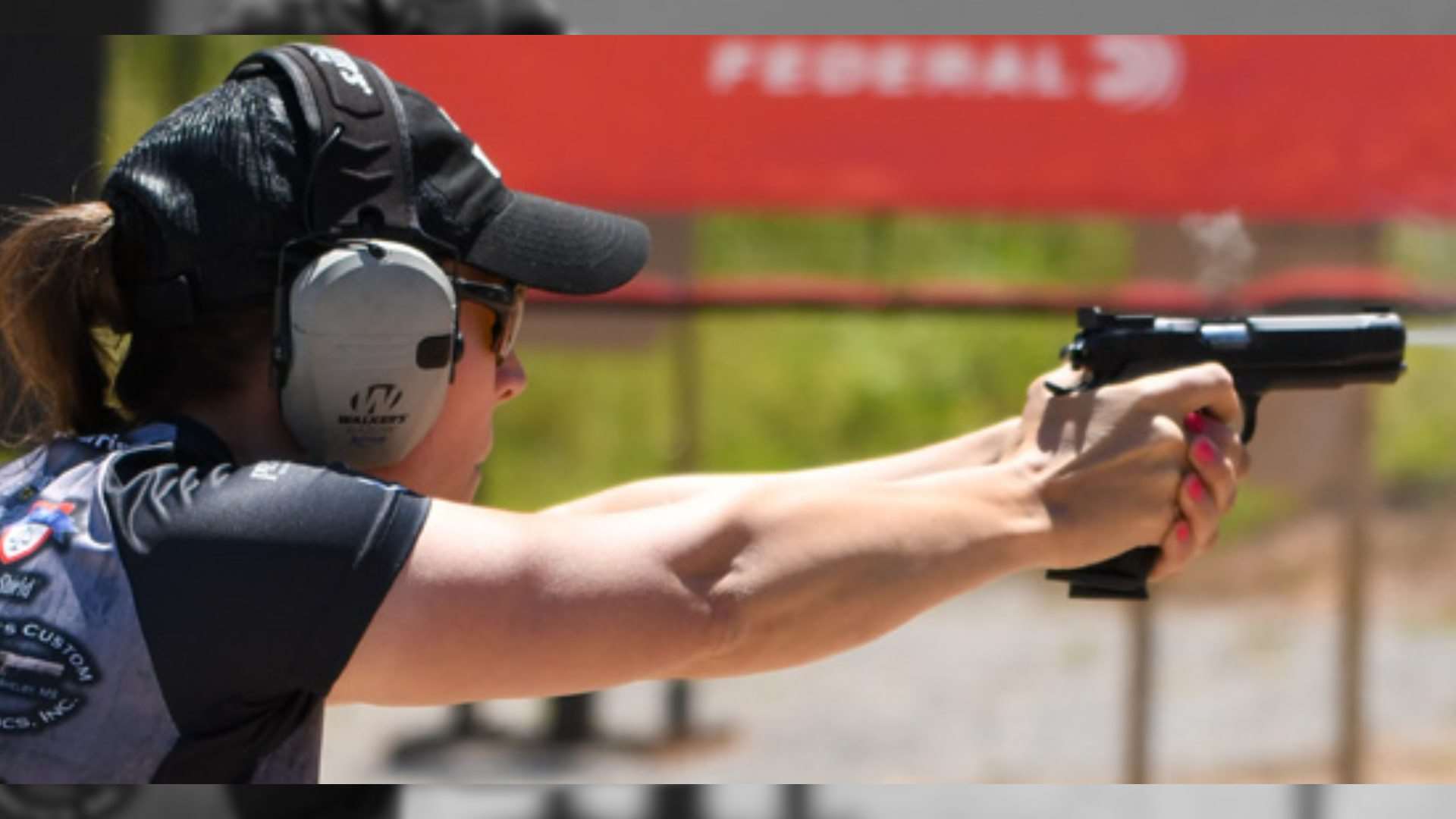
The other long course was next for the squad with 160 points up for grabs. Leatham’s 21.56-second run had a miss and procedural, while John McClain had four misses and a no-shoot, dropping the duo way down the list on this stage that was won by Randy Arrowood. Giordano took another stage win, giving him 310 points on the first two stages of the match. Stage 4, “Otto volte tre”, is a classifier contender stage. This 24-round, 120-point stage has four targets on the right side of the first wall section, move forward to the second group of four targets and finishing on the left side with the last group of four, hence the names “8 times 3.” Each group of four cardboard has tight no-shoots mixed in with the open targets, just begging you to push too fast and pop a no-shoot. Jeremy Reid took a stage win here in Single Stack and Travis Tomasie with his slick reloads won this one in L10.
The Stage 5 “Scarico” with its unloaded start requiring seven rounds on each side was going to keep the Single Stacker honest with only one round for make-up on the six poppers and double activated targets on the left side. Mike Seeklander took the Single Stack stage win, adding the 70 available points. Christian Sailer set his Open gun down and was driving an iron-sighted L10 gun for this match, winning his first stage. The squad would hit chrono before moving back to Stage 1 to finish out the day. Tomasie won the 20-round stage ahead of Sailer, and Leatham finally woke up on the final stage of the day, taking his first stage win for the day. John Vlieger was leading Single Stack with 548.17 points ahead of Elias Frangoulis with 534.85 points. Mike Seeklander was a few points up on Leatham, 529.64 to 524.35 and McClain’s tough first day had him down with only 473.82 points. Sailer was leading L10 with 593.66 points ahead of Gianni’s 586.71 and Casey Reed with 545.51.
Day 2 started in the morning for the Single Stack and L10 Super Squad in Zone B with eight stages facing them. The squad would start on Stages 7 and 8 in the shared bay. 70 points were up for grabs and this was the zone to try and make up lost ground. “Divertente,” Stage 7, was won by Robert Cernigoj with Leatham taking second and earning 63.82 points. In addition, Vlieger and Seeklander went third and fourth on this double activator stage. Justine Williams showed the boys how it was done on this stage, taking the win over Sailer and Tomasie. The Virginia Count stage “Clarus,” Stage 8, was won by Giordano with Sailer picking up a no-shoot here.
Stage 9 was the squads’ first long course, with 150 points available. The breakdown with eight-round mags was going to require four positions that allowed only one extra round for makeup shots. Frangoulis ran it in 20.18, taking the stage win and 150 points over Todd Jarrett and Seeklander. The extra two rounds in the L10 magazines could allow them to shoot this stage in three positions, but it would be a riskier plan. A 21-second-flat run took the stage win for Giordano, who was racking up several stage wins now. Sailer took the stage wins on the next two stages, adding 170 points to his total however, keeping Giordano in a close second place.
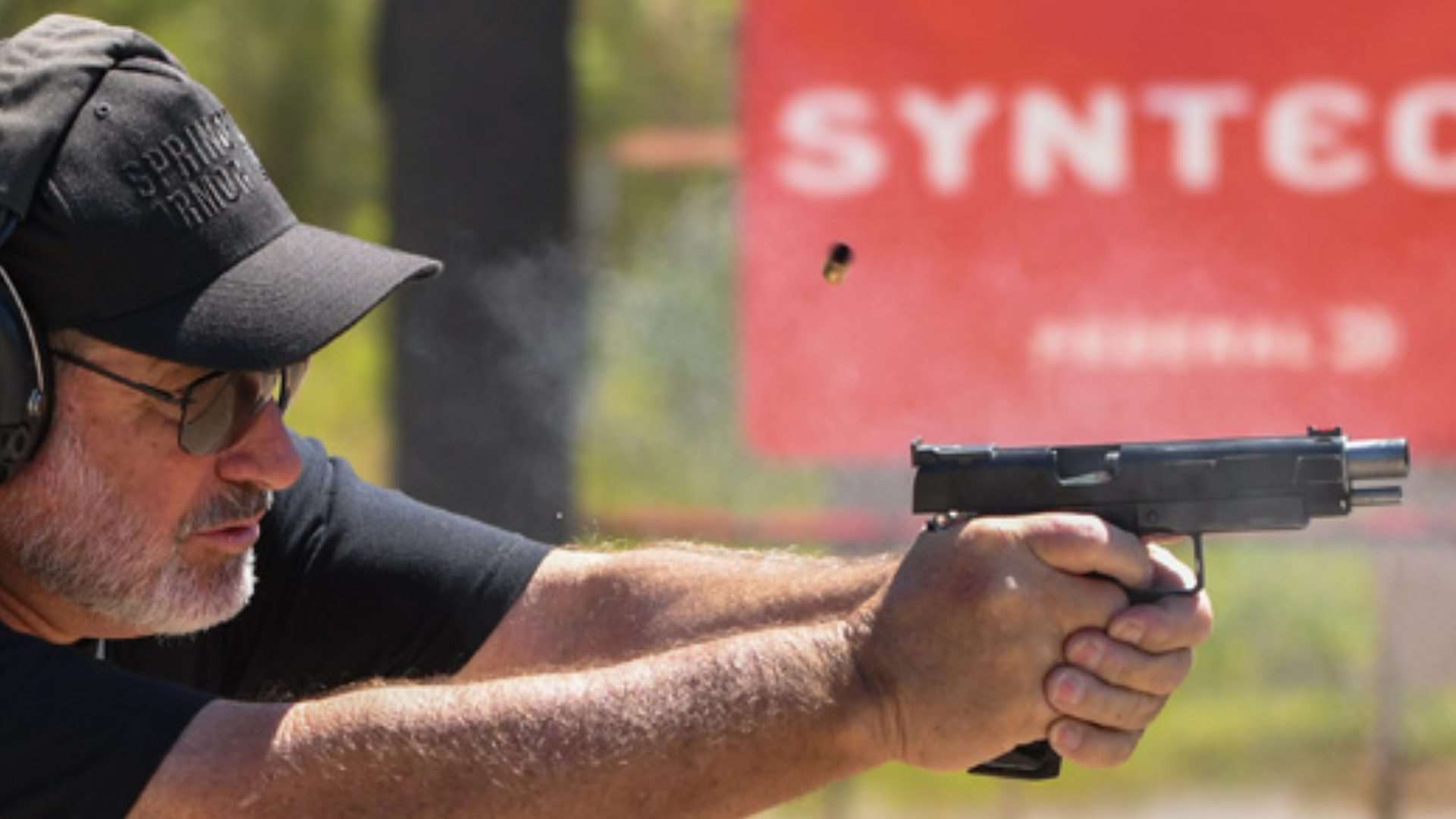
The skinny mag guys were going to have to work Stage 10 a little differently with their eight-rounders. The stage gave an advantage to ten-round guns by eliminating one reload. Even with that, only Mike Foley shooting minor finished in the top ten on this stage where the win went to Frangoulis, followed by Leatham. “Rilegato,” Stage 11, was a Virginia Count stage with hardcover and strong-hand-only mandatory shooting; this was won by Jeremy Reid, picking up the 80 points here. Stage 12 “L V” was another classifier candidate stage with 10 rounds and three positions. With a start in the middle of the rear fault line, competitors have to go to both sides for the first three targets, two on the left and a single target on the right, before moving forward to the two downrange targets. Single Stack major with eight rounds were going to have to reload; most did this after they went left first, taking the four shots, then moving right, reloading for the right target and then going forward for the final two targets. Vlieger shot 48 of the available 50 points in 6.45 seconds for a stage win over McClain, earning 48.75 points.
“Quindici” with its tip-out target that you either nailed or not was up next for the squad. Vlieger grabbed another stage win and the 75 points, with McClain and Leatham taking fifth and sixth on this fun stage. Sailer ran this in 8.26 seconds with only one Charlie for another stage win before the squad moved to the long course to finish out their second day of shooting. Stage 6 “Molti Posti” had 160 points up for grabs for the squad as they prepared to take on this field course. Not the fastest time with 24.32 seconds, but shooting 156 of the available 160 took a final stage win for Sailer for the day. There was a lot of movement on this stage, and Leatham was off the pace with a 30.73 run, finishing with only 131 of the points in 27th place. Todd Jarrett took the stage win, followed by Frangoulis earning 157.17 points for his second spot.
Day 2 ended with Sailer adding 738 more points to easily hold his lead over Giordano in second and Reed holding third, making up ground and adding 695 points. Elias Frangoulis added 690.62 points compared to Vlieger’s 666.01, moving him into the lead with 1225.47 points over Vlieger’s 1214.18. Seeklander was leading Leatham by one point after Day Two, and McClain was sitting 50 points back in fifth place.
Day Three moved the squad into Zone C with all IPSC targets and seven stages to go. Stage 15, “Ventiquattro,” greeted the squad Sunday afternoon with 24 rounds, 10 IPSC targets and four poppers. The eight-round guns were going to be pushing here, with no room for error, as the layout favored the two additional rounds in a minor-scoring gun. That being said, only two minor guns with ten rounds were in the top ten. Paul Kerr edged out Leatham for the stage win and Rob grabbed a much needed 117.2 points here. Sailer and Reed both shot the same 117 points, but Christian’s 12.57 time was 0.12 seconds faster for the stage win. Stage 16 “Parabellum” had 70 points available for the 14-round stage with six IPSC targets and two poppers, one that activated a swinger. The right-side targets were at a hard lean, and shooters had to watch the foot faults. Some plans actually had competitors switch to strong hand only to take the target. Travis Tomasie won the stage in L10; Leatham had a miss and Seeklander nailed a no-shoot. Robert Cernigoj won the stage and McClain earned 64.4 points, finishing fourth.
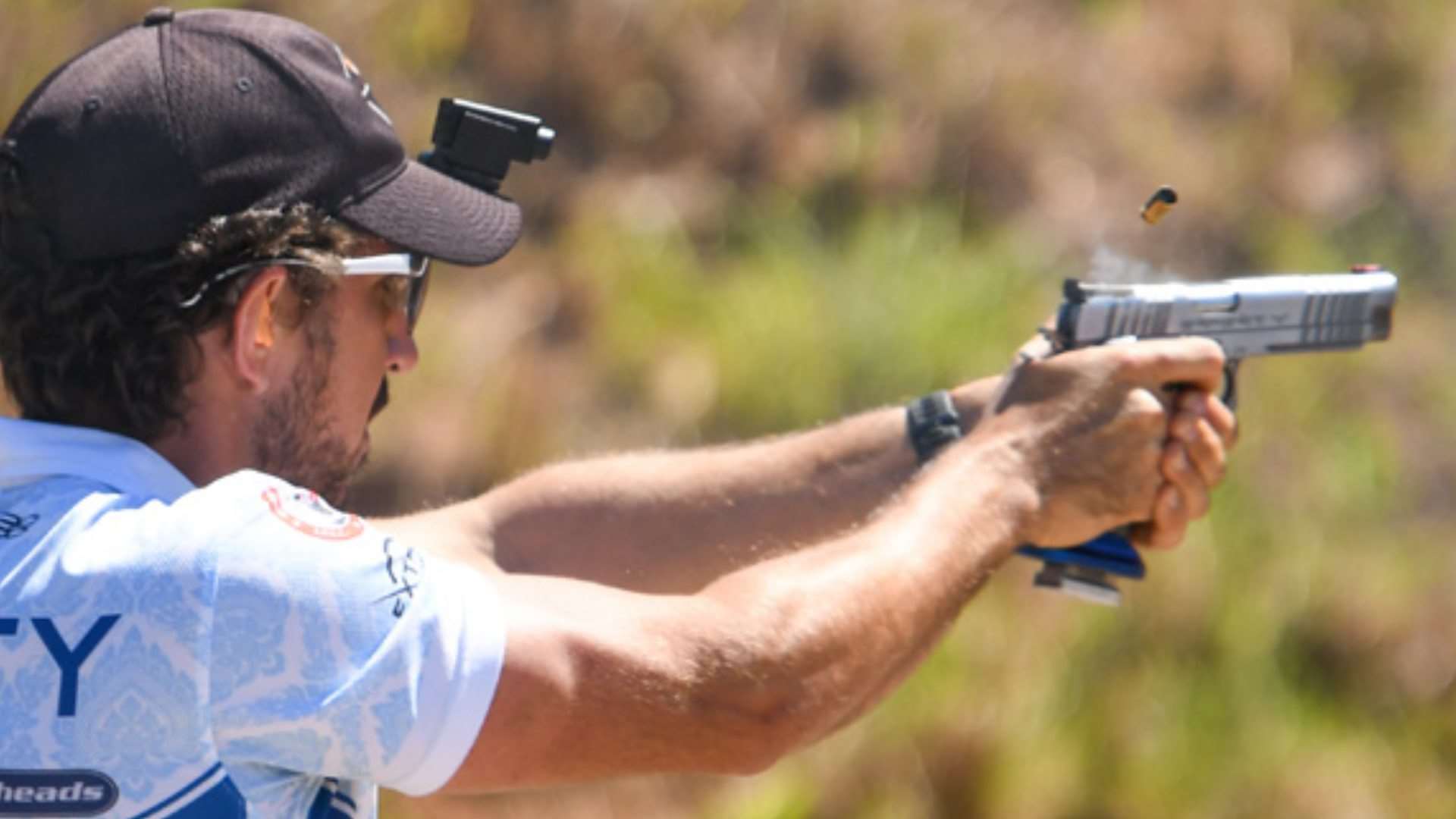
Stage 17 “Questi e Quelli” shared the bay, requiring 16 rounds with seven IPSC targets and two poppers. One of the poppers activated the disappearing drop turner. The stage was two boxes, with four wide-open IPSC targets to hose on, then go right to get the timing with taking the poppers, both paper and then the drop turner. Todd Jarret grabbed another stage win as did Sailer, shooting it in 6.17 seconds and dropping only one Charlie.
There were 150 points available on Stage 18, along with a chance to make up ground, but it would require a lot of movement with 13 IPSC targets and four poppers spread out on this wide bay. Robert Cernigoj ran it in 20.17, a little better in points than Mike Seeklander’s 20.10 run for the stage win. Seeklander earned 144.2 points, with Frangoulis and McClain finishing fourth and fifth; Leatham was 11th, adding only 128.7 points. Sailer added another stage win here. They only had a few stages to go at this point, with Stages 19 and 20 both worth 80 points each. McClain grabbed the stage win on 19 ahead of Leatham, who earned 78.9 points. Leatham would take the 80 points and stage win on Stage 20 with McClain at only 86 percent getting just 69 points on this stage. Sailer and Gorka Ibanez would trade wins on Stages 19 and 20.
Going into the last stage, the point spread for Single Stack had changed, with Rob Leatham leading the pack by 25 points ahead of Elias Frangoulis. McClain had moved into third position, while Seeklander and Vlieger were separated by only 0.43 of a point for fourth and fifth. It would be a close race to the finish with 130 points available on Stage 14, “Due Porte”. With a start in the center wall in the shooting area, there were four poppers downrange, two targets through the left port with three more in the uprange position, before moving to the right with four more targets, then a transition to the last two through the other port. The breakdown for eight-round guns was again putting a premium on not having make-up shots on the poppers. Leatham would secure his second consecutive Single Stack title, taking the stage win and all the 130 points to push him to victory. Sailer would also take his final stage win and first L10 National title. Gianni Giordano scored 93 percent for second place and Junior National Champion honors, with Casey Reed at 92.9 percent in third. Elias Frangoulis came in second at 97.8 percent, John McClain third with 97.4 percent, Mike Seeklander fourth at 97.3 percent and John Vlieger fifth with 96.8 percent.
Jalise Williams and Jessie Harrison would trade spots over the three days competing together on the same squad. Also on the squad were Justine Williams, Lanny Barnes and Jessica Hook shooting L10. Justine Williams would claim another Ladies National Champion title in L10, with Jessica Jonasson in second place and Becky Yackley in third. Randi Rogers was on an opposite schedule and snuck in under the radar, winning seven of the stages and second on several others against the other ladies, claiming the Ladies National Single Stack Champion. Jalise Williams was second and Jessie Harrison was third. Ashley Rheuark was on the Ladies squad shooting her Glock in Production, winning the Ladies National Champion title. Linda Hilton was second and Kaylee Bennett was third.
Production Race
The Production Super Squad was stacked with previous year’s winner Jacob Hetherington, followed by Mason Lane, Sal Luna, JJ Racaza, Nils Jonasson, Shane Coley and Phil Strader to shake things up. The Production squad was on the Friday afternoon, Saturday morning and Sunday afternoon schedule starting on Stage 1 in Zone A—the perfect stage to start on for the ten-round capacity of the Production guns. But the “Dieci Dieci” (“10 10”) stage layout gave many options on how to solve this problem that were not just 10 here and 10 there, although you could if you wanted to. There were nine USPSA targets and two poppers, one activating a bobber that hid the lower A zone with hardcover. A start in the center of the rear fault would require shooters to go to both sides before moving forward, deciding where to get their reload done. Nils Jonasson ran this in 13.39 seconds, shooting 94 of the available 100 points and taking the first stage win over Hetherington’s 12.77 with only 88 points. Mason Lane earned 90.6 points here with a sixth place finish and Racaza was off the pace with a 14.33 second run and just 84 points shot.
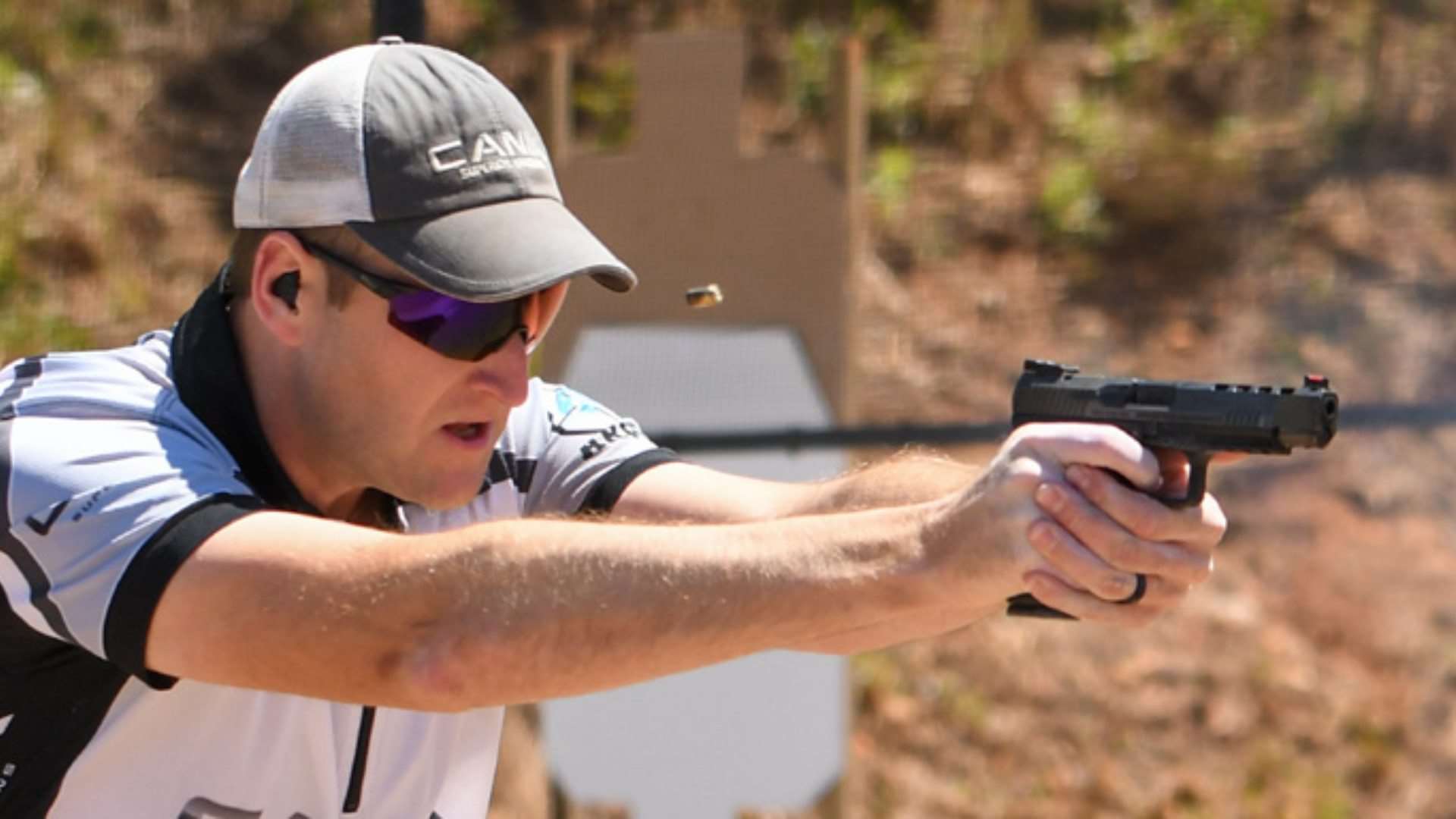
The 30-round, 150-point Stage 2 “Trenta” boasted 11 USPSA targets and eight poppers, including one that activated a fast swinger. The start was centered on the rear fault line, to the left was an array of poppers and three paper targets through a port, and to the right was an array of two paper and two poppers. From the right side, back of the shooting area, there was also one downrange target that could only be taken from there. Another port on the left side wall section had a double stack of targets to be engaged before moving forward for a target tucked back on the far left side, then four poppers downrange with one activating the swinger that appeared on the far right. Racaza lead the pack with the stage win, getting the 150 points, but Nils earned 149.27 for second place and Mason Lane finished third with 148.39.
Nils had taken an early lead and was up over Mason 249.27 points to 238.97, with Jacob in third ahead of JJ 234.86 to 233.49. Stage 3 “Triginta Dou” was worth 160 points and was the biggest stage in this zone. This had a downrange start, with lots of options on how competitors would work their way back uprange, engaging the 16 USPSA targets. Mason Lane took the stage win and 160 points, with Jacob coming in second with 149.44. Nils was just ahead of Racaza, earning 147.31 to 145.8 points. Stage 4 had another 120 points available, and Racaza grabbed a stage win here ahead of Phil Strader in the second spot. After four stages Nils and Mason had changed leads twice, with Nils now up 507.50 to 505.53. Jacob was leading JJ by .46 of a point for third, 499.8062 to 499.3394 going into the final stage of Day 1.
Stage 5 “Scarico” had the unloaded start and double activated targets for the 10-round minor guys to work through. It only took 9.01 seconds to for Racaza to turn, load, engage two paper and three poppers on the right, load moving to the left, engage three poppers, the max trap target and bobber to secure the stage win—shooting all alphas on this one to finish the day. Nils was at 86.6 percent, earning 60.62 points for a second-place finish on this stage. The squad would move to chrono for their final stop. Racaza was happy to go 126.1 power factor at Chrono and was leading by 1.22 points over Nils, 569.34 to 568.12. Mason Lane was sitting in third at 557.16, with Hetherington at 538.20 and Sal Luna at 518.17.
With a 9:00 a.m. start due to Alabama law for public ranges stating that you cannot fire rounds before then, many of the Super Squad guys were practicing their dry-fire skills in the demo area. Eight stages and 755 points were ahead of them for the morning session of shooting. The 160 points available on Stage 6 started off with a stage win for Mason Lane, who shot 158 of the points in 24.06 seconds, compared to Racaza’s 22.47 second run but with only 144 points shot for third. Stage 7 “Divertente” with its two boxes and double swingers, one from each side, with a table start and a reload that came from the barrel top between boxes was their second stage of the day. The reload ammunition was supposed to come from the top of the barrel, where there were magnets screwed down, hence the name “Divertente” meaning funny—my inside joke about the updated magnet rule. However, I didn’t write the stage brief correctly and it wasn’t questioned until the last squad on day two of the staff match. So, most competitors just laid their reload on the edge of the box and wondered why in the hell their magnets were screwed down. Lesson learned. Hetherington shot this clean in 9.04, all Alphas for the stage win, with Lane a close second, earning 69.38 points.
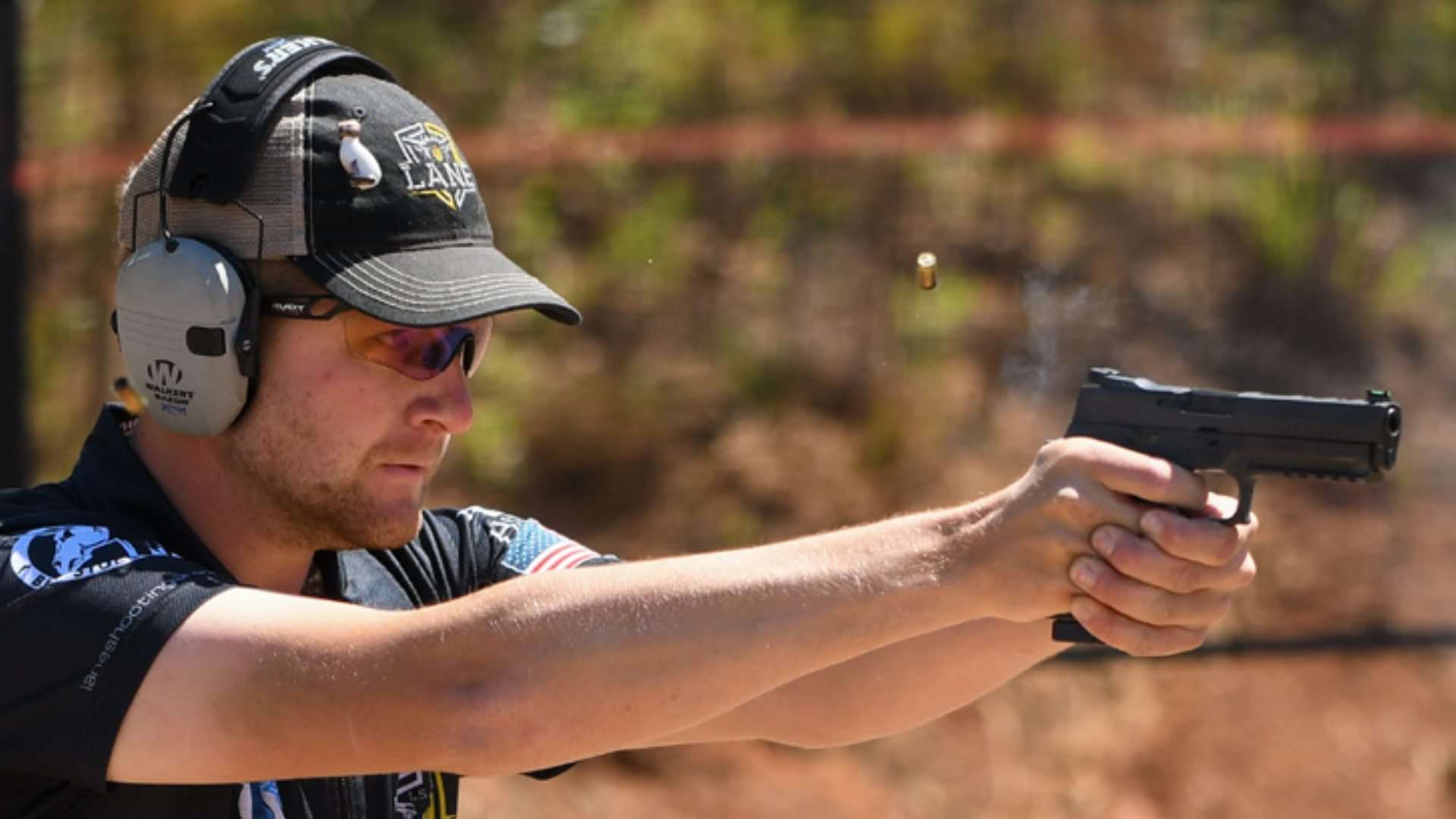
The first Virginia Count stage for the squad, Stage 8 “Clarus” was a stage win for Shane Coley with Lane in the second spot, while Jonnasson finished fifth and Racaza in 11th. “Lontano,” Stage 9, would have 150 points available and the option to have a little riskier stage plan that eliminated a position, but could lead to having to do a flat-footed extra load if they didn’t execute the plan. Jonasson ran it with a 19.63-second time with 28 As, one C and one D for a stage win over Hetherington, and Racaza in third. Lane was off the pace with a 22.01-second run, better hits but only managed 11th place for 128.2066 points.
The next four stages were all short or medium courses starting with “Eh-leh,” Stage 10, with 18 rounds, seven USPSA targets and four poppers. This was a straightforward stage, a hands-on-marks start with a move to the right for ten rounds, and then to the left and forward for the remaining eight shots. The first position had two poppers, and downrange in the second were two more with three paper. Nils’ 10.42 second run wasn’t the fastest but only one Charlie gave him the 90 points he needed on this stage win. Jacob was second and Racaza at 93 percent for third. “Rilegato,” Stage 11, was the hardcover with a mandatory reload into strong-hand- only stage worth 80 points. Mason Lane added this to his stage wins, picking up the 80 points. Jonasson added only 60.04 points here and Racaza had a miss, earning only 56.96 points.
Stage 12’s 50 points with its 10 USPSA targets was a stage win for Racaza, running it in 6.44 seconds. Lane also shot this in 6.44 seconds, but with one Charlie for second place. Hetherington had a miss, dropping him back down with only 32.49 points earned. All that was left for the day was Stage 13 “Quindici,” worth 75 points. Racaza took the win here with a 7.19-second run with two C’s, ahead of Nils’ 7.63 run with only one C hit. Lane was third on this stage at 90.8 percent. At the end of Day 2, the top three were separated by just six points, with first and second separated by 0.098 points. Mason Lane had 1272.873 points, Racaza with 1272.775 points and Nils Jonasson third with 1266.28. Additionally, Jacob Hetherington had 1223.06 points.
The final day of competition would start on Zone C, all IPSC targets for the squad that was shooting minor. With a reduced-size A zone, accuracy was at a premium on the final seven stages to determine the 2021 Production Champion. Stage 14 kicked things off on that Sunday afternoon with Nils Jonasson adding 130 points to his lead, taking a stage win and running this 26-round stage in 12 seconds flat with only three Charlies. Lane would drop to fifth, earning 113.02 points and Racaza ninth, adding 108.56 points.
Stage 15 “Ventiquattro” was a simple-looking stage on the surface but had some pitfalls for low-capacity divisions. It was a design that I borrowed from Danny Minter and spread out in a wider bay, which left some optional targets available from multiple positions, and some targets set up to suck you into wanting to go too fast. During setup I spent time getting the placement of the targets just so from certain spots in the side-to-side rectangle shooting area. This stage was a game-changer for many in this zone. Jacob Hetherington grabbed a stage win and the available 120 points with a 11.52-second run; Nils would finish third here, earning 109.98 points. Racaza had a miss with a no-shoot finishing 64th and earning only 80.17 points and Lane had a miss, earning only 86.77 points. Nils was now sitting at 1506.27 points with Mason in second at 1472.68 and Racaza in a close third spot with 1461.5. Jacob’s stage win brought him in closer with 1451.77 points as they moved into the final five stages.
Stage 16 “Parabellum” became a much mentioned stage with a popper that had some reshoots because it didn’t fall during calibration for some competitors, and did fall for others, resulting in a miss. We can discuss popper calibration and the rules and scour the internet for how many times this happens for days on end. Unfortunately, there are many factors to take into account, specifically with this popper, the soft ground, the wind that was blowing over steel and the power factor of ammunition used that resulted in this being a difficult popper. The steel had been calibrated trying to keep the wind from blowing it over, and the next squad up was the Single Stack Super Squad, with everyone shooting major, and they had no issues for them. The Production squad was next up, all shooting minor, and there was a popper that Racaza left standing with a good hit in the calibration zone that went down during the calibration shot from the Range Master. Jared Fox was up next and had a good hit on the popper that when shot for calibration didn’t go down, resulting in a reshoot. In a tight race like what was going on, it is unfortunate that there was a mechanical failure of a prop. Nils crushed the stage with an 8.69-second run, winning it, with Shane Coley finishing second and Lane in third, picking up 67.22 points. This stage win put Nils with 1576.27 points, Mason in second with 1539.89 and Racaza with 1514.19 points and still in third.
Stage 17 “Questi e Quelli” was only worth 80 points, which Racaza came back and won, with Lane taking seventh place earning 74.64 points and Jonasson in ninth adding 72.57 points to his total. If there was any ground to be made up, it would have to be on Stage 18 “Quattro Angoli,” a 30-round stage worth 150 points. The wide long course was going to lend itself to the foot speed of Racaza, who took the stage win, shooting this in 18.36 seconds, a second-and-a-half faster than the next shooter. Sal Luna would take second here with Lane in fourth and Nils dropped down to a 16th-place finish earning 116.65 points.
There was only 160 points left to grab between stages 19 and 20. Nils was sitting at 1765.49 points in first, Mason was 20 points behind in second at 1745.49 and Racaza closed the gap with 1744.19 points in third.
There was no room for errors on the last two stages, with only 20 points between first, second and third. A miss, a no-shoot—even a malfunction—could swing the match in any direction. Racaza was still trying to make up ground and pushing hard, blazing through Stage 19 with an 8.42-second run dropping only one Charlie to pick up the stage win and the 80 points. Jacob Hetherington was also still fighting, coming in second and earning 75.53 points, but Nils was not just sitting back and coasting either. He took the third spot with 74.31 points and Lane dropped down to eighth place with a 9.21-second run with a Delta that cost him his second place, dropping him to third with a total of 1814.88 points. Racaza moved into second place now with 1824.19 points, just 15.6 points behind Nils at 1839.80 points.
Having the match come down to a final stage that was going to be based on getting your hits weak-hand may seem poetic in a shooting competition. Hindsight tells me that is was something else. Do you go hero or zero here? Do you put up a good solid run and hope for the best? Sal Luna ran the stage in 9.32 seconds with two Charlies, Jacob Hetherington had an 8.32-second run with a Charlie and a miss. Nils had a 10.06-second run with a Delta, Mason laid down a 6.86-second run and Racaza had a 7.93-second time for his. Racaza won the stage with four Cs and a Delta, Lane had two misses and two Deltas with five Charlies.
When the final scores were tallied up, Nils finished with 1904.7143 points and Racaza was at 1904.1856. That is 0.5287 points between the National Champion and runner-up. Mason came in third with 1858.4 points, with Jacob Hetherington in fourth place and Sal Luna in fifth. That’s three long days of shooting with highs and lows for everyone who shot the match. The stages during walkthrough seemed less complicated, until the buzzer went off and the difficulty of executing their plans caught many off guard.
The Vendor area and Demo bay were full during the match with Beretta’s large trailer parked in the center, flanked by many regular sponsors and some new vendors on hand like Colt and GX Products. The hard-working staff also had many familiar faces as well as many new staff that took advantage of being able to shoot the match and gain the experience of working a National Championship. We cannot thank the staff of Range Officers, Quartermasters, Mr. Fix It, setup crew and support staff enough for all their hard work. We are looking forward to seeing everyone at the USPSA Back To Back Nationals in October.
Article from the July/August 2021 issue of USPSA’s magazine. All photos by Jake Martens.
Read more: Review: Ruger Custom Shop SR1911 Koenig













